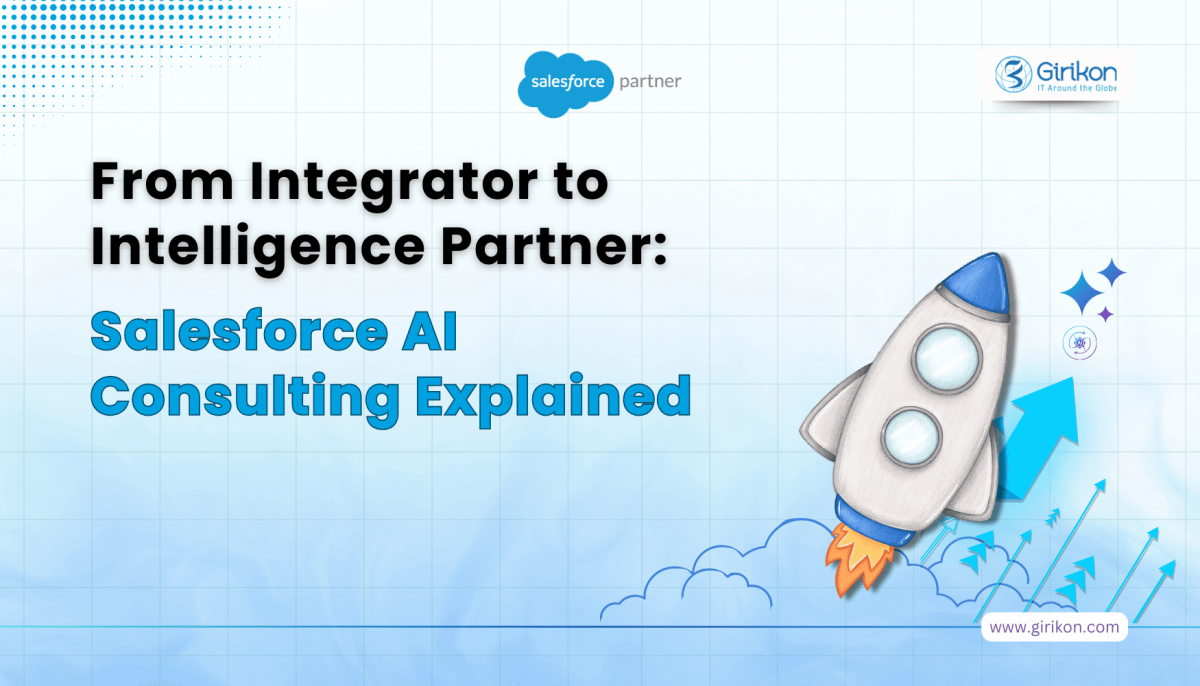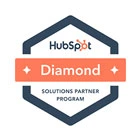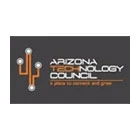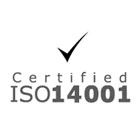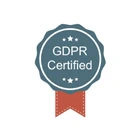If delivering personalized experiences to your customers at every touchpoint is a priority, leveraging Salesforce Marketing Cloud makes sense. Organizations can leverage this omnichannel marketing platform to plan, personalize, and optimize their marketing campaigns to make their workflows effective and efficient. However, to tap into the complete potential of the Salesforce marketing cloud, it’s essential to ensure its’ successful implementation. Reaching out to a certified and experienced Salesforce Consultant can be advantageous.
It’s essential to take note of the following best practices to ensure the strategic and successful implementation of Salesforce Marketing Cloud:
Determine a Starting Point: Salesforce Marketing Cloud is made up of multiple tools. However, it isn’t easy to implement them instantly and leverage their benefits. So, it is essential to set your business priorities, customer needs and processes while determining a starting point and then figuring out which tool to start with.
Gather the Right Team: It is essential to bring the right people aboard to ensure the successful implementation of the marketing cloud. It is vital to have people who can represent your business and associates with strong technical acumen in your team. It is also crucial to identify sponsors and stakeholders who will be involved in the implementation process.
Establish a Clear Goal: Once you have determined the starting point and have brought the right team in place, it’s time to define a clear goal using Marketing Cloud for your first project. Choosing a measurable goal is suggested related to business objectives to exhibit greater return on investment.
Define Your Audience: Once you have set your goals, it’s time to define your audience and then after your plan has been established, clarify your audience (both from business and technical perspectives) and then resolve any discrepancies in your CRM. Recognize and gather data required to run a campaign for your target audience.
Map the customer journey: Make sure you factor in all the channels and touchpoints to evaluate the existing state of your customer’s journey. Also, ensure to identify the significant challenges and recreate their journey to make the most of the marketing cloud product you are leveraging.
Communicate Effectively: Effective communication is a significant aspect of managing change, creating liability and transparency. It’s essential to develop a plan for stakeholders and sponsors to communicate your adoption of the marketing cloud. To keep making progress, make sure to raise performance, increase learning, and remove roadblocks.
Move Ahead with Urgency: Don’t allow anything to hinder your adoption of Marketing Cloud. Make sure you move toward the launch date with urgency by imbibing flexibility within your team’s culture.
Take Time to Review: Finally, take some time out to retrospect what worked in your favor and what didn’t and all this from a team and client perspective. Rejoicing success and collecting feedback is critical to improving your cloud practice over time.
Final Words:
It takes time and patience to get started with Salesforce Marketing Cloud. Every participant part of the implementation process should have a strategic mindset to work through the lengthy implementation process. Once done successfully, the results are attained in saved time, streamlined workflows, and augmented productivity. It is essential to seek Salesforce support from a reliable implementation partner to ensure successful implementation.
Fast Track automation and innovation with AI across Salesforce.
Salesforce Einstein is your personal data scientist designed to make you smarter and more predictive with Artificial Intelligence to better connect with customers. Einstein delivers powerful visualizations of data, offering predictions for sales teams, predictions of which deals are likely to close, forecast predictions for business and offers recommendations based on customer behaviour. Old data is collected and connected within Salesforce so that all departments can work together seamlessly sharing data to help each other succeed. Einstein for sales can help pursue better leads based on data predictions on who is more likely to convert. Einstein for services allows you to have chatbots answer all of the rudimentary service requests so customer service can focus on higher priority cases. IT can use automated predictions to improve workflows and business processes which thanks to Einstein are so intelligent that they automatically adjust based on incoming data including 3rd party data to better engage with customers. And all of the data is crystal clear with Einstein analytics. So everyone has the visibility and key data insights to grow their business faster than it was ever thought possible.
One might ask where does Salesforce Einstein stand compared to other enterprise AI platforms. The differentiator is that Salesforce Einstein is intrinsically integrated into the core product itself allowing companies to apply the AI technology to their business immediately. With Einstein you don’t need additional group of data scientists and extensive resources to go Live with it. Salesforce Einstein has AI built into the CRM to make it as simple to use as possible. Einstein delivers AI to every Salesforce user. It provides the following benefits:
Production Ready
Einstein is seamlessly integrated into many Salesforce products. To use it, you don’t need to do any data modelling or preparation of data separately. Just put your data into Salesforce and Einstein will use that data to help you become smarter and more predictive about your customers.
Data Security
Einstein is built on the robust security architecture of the World’s No.1 CRM platform that is trusted by more than 150,000 companies across the world.
Cross Functional AI
Einstein is available through all options of Salesforce – Sales Cloud, Service Cloud, Marketing Cloud, App Cloud, Analytics Cloud, and Community Cloud.
Image Source – salesforce.org
Get smarter advice with Salesforce Einstein.
Salesforce Einstein uses Artificial Intelligence (AI) that uses predictive grading techniques to recommend the best next steps to meet key financial goals. It smartly automates routine tasks so that you can spend more time with your customers.
UNDERSTAND AND ENGAGE
Get deep insights into your customers from past interactions. Use these insights to deepen relationships, prioritise opportunities, cases, and campaigns and drive productivity.
Image Source – salesforce.org
Image Source – salesforce.org
INCREASE PRODUCTIVITY
Enable your teams to get more done in a shorter period of time with smart case classification, next best actions, and recommendations.
Provide swift resolution to their queries or information they seek and automate the best action to take.
SCALE CUSTOMER EXPERIENCES
Use smart bots to answer common customer questions, thereby enabling your agents to address more complex and urgent cases.
Empower your agents with AI that allows them take on tough cases with recommendations, replies and knowledge.
Image Source – salesforce.org
Here are 3 key features that everyone’s taking about in Einstein:
MACHINE LEARNING
Get smart predictions about your business and customers.
Machine learning uses past data to forecast the future in a literally codeless environment.
Einstein Discovery
Discover relevant patterns in all your data, whether it lives in Salesforce or outside, and boost productivity. Discover AI insights and recommendations on complex issues. And take action on your discoveries from within Salesforce.
Einstein Prediction Builder
Predict business outcomes of key parameters. Create custom AI scenarios on any Salesforce object or field with just a few clicks.
Einstein Next Best Action
Deliver actionable recommendations to employees and customers, right from within your workspace. Define recommendations, build action strategies, predictive models, view recommendations, and initiate automation.
NATURAL LANGUAGE PROCESSING
Extract contextual meaning from text.
Use natural language processing (NLP) to find semantic patterns to answer questions, respond to requests, and identify conversations about you across the web.
Einstein Language
Understand how customers feel, automate routing of inquiries, and streamline workflows. Build natural language processing capability into your apps to qualify the context in a body of text, irrespective of language.
Einstein Bots
Build, train, and deploy custom bots effortlessly across digital channels that are connected to your data. Improve business processes, empower employees, and deliver customer delight.
COMPUTER VISION
Get a complete picture of your products and brand.
Computer vision includes visual pattern identification and data processing to track your products and brand, understand text in images, and more.
Einstein Vision
View the entire conversation about your brand on social media and beyond from within Salesforce.
In the end, AI is all about using data to establish patterns, predict outcomes and simplify decision making for customers. With the right Salesforce Consultant, you can leverage Salesforce Einstein to fast track growth and stay ahead of the curve.
Discover how a Salesforce Implementation Partner can deliver the power of Einstein for you.
Contact our expert today!
CONTACT US
Salesforce Financial Services Cloud lets Bankers, Insurers and Advisors build trust by unifying the customer experience to grow their business and deepen customer engagement. Financial services managers can accelerate digital transformation by delivering a personalised service that customers expect. Get a single view of each customer’s activity across channels, geographies, and lines of business, both consumer and commercial. Now everyone across your financial institution, can visualize customer relationships and associated key information in one place, to drive trusted customer interactions. Provide your customers with a consistent and engaging experience across channels.
Salesforce Financial Service Cloud makes it easy for your customers to connect with you from anywhere at any time with customizable communities. It allows you to manage goals, cases, policies, and documents in a unified platform to create a single source of truth for your customers. By identifying live events and areas of opportunity to drive contextual action for investments, lending, mortgage, and insurance right out of the box, the Customer360 platform empowers you to build trusted customer relationships for your financial institution.
Deliver experiences that drive client loyalty.
Scale-up your business.
Deliver personalized advice from any time, anywhere with smart customer insights and engagement tools. Delight clients at opportune moments by collaborating with them on their financial goals.
Benefit from greater and clearer visibility into existing household opportunities and get a holistic view of all financial assets. Track referrals from Centers of Influence, and transform your client base into a potent referral network.
Work smarter and maximize work efficiency
Manage compliance with confidence.
Instantly access all of your client data at one central location. Free up time spent on routine administrative tasks and invest more time in fostering client relationships. With a device-friendly custom app, advisors can maximize every hour on the go.
Drive collaboration across the entire organization. Get secure access to client and household profiles and manage compliance. And get instant visibility on client interactions and information shared with them.
Let’s look at some of the core benefits delivered by Salesforce Experience Cloud:
Lead Tracking
Financial Services Cloud allows you to keep a close watch over leads and referrals. It comes with productivity-enhancing tools and integrated apps that help your teams keep track of all opportunities from generation to conversion.
Activity Tracking
Financial Services Cloud eliminates communication gaps amongst team members. It automates critical tasks to meet the specific goals which can be auto-assigned to appropriate team members based on their profile. As a business owner, it will give you a bird's eye view of progress.
Advisor Analytics
Salesforce Financial Services Cloud is powered with the Lighting Dashboard that is designed to assist financial advisors to make smart and informed decisions for their clients, driving growth. Users can effortlessly customize their dashboards to deliver relevant snapshots for assisted decision-making.
Unified Data Model
With Financial Services Cloud, financial advisors can effortlessly manage their customer's data model, household models, individual data model account, or personal account data model, all on a single unified platform.
Turbocharge Customer Care
One of the most powerful benefits of Salesforce Experience Cloud is its intuitive customer care. Customers always expect more, including advice, prompt query resolution, open communication, and more. Salesforce Financial Services Cloud allows companies to meet all these expectations. Experience Cloud keeps a track of all of the customer's activities, visualizes customer relationships, streamlines coordination among stakeholders, and delivers complete transparency.
Enhance Engagement
Salesforce Experience Cloud enriches the engagement amongst all business cycle constituents – customers, advisors, partners, employees. It unlocks new opportunities and augments the whole digital experience. By leveraging the power of AI, Salesforce Experience Cloud delivers reliable and trustworthy analytics, empowering companies to make swift, informed, intelligent decisions.
Conclusion
Salesforce Financial Services Cloud is a powerful tool for wealth managers, bankers, insurance advisors, and business and IT executives. It empowers them to make faster and smarter decisions thereby driving up productivity. In simple terms, it allows you to stay ahead of the curve. So if you are in the business of financial services, and want to turbocharge your productivity and growth, talk to a Salesforce Consultant today and begin your new journey.
Questions?
Our reps have answers.
CONTACT AN EXPERT
In today’s competitive business landscape, it isn’t easy for customer-facing teams to manage their customer relationship without the help of CRM (Customer Relationship Management) software. Besides managing customer relationships, a powerful CRM can help in achieving operational and business process efficiency. This explains why many organizations, irrespective of their size, use a robust CRM.
However, to maximize their ability to reach and engage with leads, organizations should leverage a CRM integrated texting App that can provide them with features that cannot be provided by individual text marketing software. One such CRM integrated messaging App is the Smart SMS App built natively on the Salesforce platform.
The robust App offers a wide array of advantages over regular SMS services. By leveraging such a Salesforce texting App, organizations tend to add automated text messaging to their ongoing marketing strategies and tactics, which will pave the way for better customer engagement and more closed sales deals.
By integrating text messaging in their CRM, brands can benefit in several ways:
It allows brands to use cross-channel marketing differently.
It paves the way for multi-channel marketing, allowing brands to attract and convert new customers while retaining existing ones.
It ensures that the right message is sent to the right user at the right time.
Brands can segment their client base and send tailored and targeted messages to every client, depending on their purchase history.
A CRM integrated SMS App will ensure improved customer relationships as the SMS functionality assures better chances of connecting and selling.
A CRM integrated SMS App will help organizations improve their brand awareness. It will become easy for customers to forward promotional messages to people in their group who might become customers.
By leveraging a CRM SMS App, organizations can send reminders for meetings, appointments, and deadlines to customers and sales reps. This will saves time and money while improve the overall efficiency of the organization.
Quick Wrap-up:
There are several other benefits of CRM SMS integration other than those mentioned here. Such an App is a crucial addition to your brand and business in general. So, if you wish to place your business at the forefront, it’s essential to include one of the Best SMS App for Salesforce as a part of your marketing campaign, which can take your business communication to a new level.
Every customer is unique. And they are demanding too! In general, customers like to know if the experience they are going to have is personalized for them or not. In fact, in a survey conducted by Salesforce across customers, it was found that 86% of them admitted that personalization played a role in their purchasing decisions. But customers aren’t the only ones who prefer customization.
Businesses around the world are equally uninterested in consuming products and services that are designed for mass consumption. They want something that fits seamlessly with their unique processes and is flexible, intuitive, and effective.
Salesforce does all this and more. The World’s No1 CRM Platform was designed specifically for configuration and customization. It comes with a plethora of unique features, tools, and resources enabling businesses to create custom apps that are aligned with their business goals and objectives. However, unlocking its true power requires a deep understanding of its customizable nature across different industries. And this is exactly where a competent Salesforce Implementation Partner comes in. With the right Salesforce Consultant and a methodically executed implementation plan, you can send the productivity of your teams into overdrive and unlock the real value of your business.
If you can’t trust a CRM platform to meet your unique business needs, then it’s likely you won’t get much use out of it. Salesforce features a totally open eco-system, which means you can extend Salesforce to accomplish any task, with apps for every business need.
CRM + UX: The ultimate customer experience
Customers aren’t just demanding vanilla products and services anymore; they are seeking an enriching experience. They are demanding convenience and deeper engagement throughout the business lifecycle. With exponential growth in technology-related products, tools, and services, coupled with today’s dynamic and unpredictable context, it is imperative for businesses to live up to these demands and offer their customers the ultimate experience.
How your business delivers products and services to your customers is as important as what you deliver. Salesforce provides you with that elusive combination of power, flexibility, and tools at your fingertips to effortlessly execute code-less customization to suit your needs.
So how does one go about customizing Salesforce to align with your business goals?
Identify opportunities and bridge gaps
An important step before the Salesforce implementation begins is to conduct a thorough assessment of current business processes and identify inadequacies and redundancies. Focus on processes that are a drain on your resources. Identifying gaps and shortcomings early is critical to a successful implementation. This is where the role of a Salesforce Consultant becomes so important. Discuss with your Salesforce Implementation Partner and answer some key questions like -How do you customize Salesforce to enhance adoption? How do you maximize your ROI? How do you reduce the learning curve? Discuss with your Salesforce Implementation Partner to understand which features are most helpful to address these gaps. Add additional functionality into your implementation by using custom codes or extended features, that is more end-user-focused and aligned with your overall goals and objectives. Look beyond standard Salesforce functionality. Customize! It’s a certain way to drive adoption.
Businesses must understand that a successful Salesforce implementation is a result of team effort as well as collaboration across departments and stakeholders. The implementation plan needs to be communicated to all concerned teams and all stakeholders need to buy into this new process of doing business.
Focus on usability
Salesforce has countless features and options, and this can be a deterrent to early adopters. Work with your Salesforce Consultant to configure the software in a way so as to present relevant data and components to optimize your business workflows. Salesforce Lightning (discussed later) can be used for enhancing productivity and drive adoption rates.
Automate
Automate repetitive tasks. By customizing templates, standardizing workflows, and automating repetitive tasks, you can significantly improve adoption rates. Businesses can now automate faster using something called Flows. You can download configurable prebuilt processes with flow templates and use the flow builder to integrate stand-alone building blocks.
Leverage AppExchange
Salesforce AppExchange is a great place to find relevant tools and plugins to get you off the blocks quickly. AppExchange is a unified ecosystem that is used for creating and running all of the personalized applications that an organization might need. Whether you are a new user or an existing one, you can discover free, customizable, customer-recommended solutions built by Salesforce developers to help you address common business issues. Whether it is tracking employee progress, oversight of projects, streamlining repetitive tasks, fast-tracking automation, or kick-starting app building, chances are that you will find a solution to your problem on AppExchange. You can effortlessly customize these tools with an intuitive drag and drop interface and get going.
Although it is possible for businesses to build and run their own apps without the Salesforce platform, AppExchange has certain inherent advantages over other potential options:
Intuitive interface. You may have a clear understanding of what you want apps to deliver for you. However, on most occasions, knowledge transfer of your goals and vision can create gaps in understanding between your developers and you. Leading to ineffective creation of apps. AppExchange features an intuitive and easy-to-master interface, so that your teams can build and deploy precise apps. This means more effective systems, and as a result, more productivity
Short development times. AppExchange provides users with effortless, drag-and-drop elements empowering users to quickly create custom, business-centric apps, potentially in a matter of hours.
Multiple development tools. Organizations are no more restricted to a limited choice of development tools. Salesforce brings together three powerful development tools — Force.com, Heroku Enterprise, and Lightning — empowering app developers with the flexibility to choose what they want in order to get the job done.
Prebuilt apps. Why re-invent the wheel? It’s likely that what you are seeking to deploy is already there on the AppExchange. You can discover thousands of existing third-party apps in the world’s largest enterprise app marketplace. Customize as you want and deploy in an agile framework.
Limitless possibilities. AppExchange is the solution across departmental needs – Marketing, HR, IT, finance, operations, and more. Businesses can build and deploy apps that can scale across a limitless number of devices and users.
Scalable Meta Data Driven Platform
As your business grows, your CRM needs to adapt right along with it. By using a single code base, Salesforce makes it possible for customers to customize and scale their CRM solutions with tools that work on the meta data layer. Whatever the need, Salesforce provides customizable, configurable solutions, and does so effectively, quickly, and with minimum effort.
Conclusion
Salesforce is committed to providing businesses of all sizes with the tools they need to empower themselves. Of the many advantages offered by the World’s No 1 CRM platform, perhaps the most valuable are comprehensive solutions, high security standards, customizability, innovation-centric design, and specifically designed apps that allow usability with limitless possibilities. With an ROI on par with the best in the industry, there’s no reason not to give it a try.
Looking for Pricing?
Contact our reps to discuss your needs today.
CONTACT AN EXPERT
Today, Salesforce is the world's no 1 CRM platform, and for good reason too. Companies all around the globe are moving their business applications to the cloud and the world’s no1 CRM platform provides the power, flexibility, and intelligence that businesses need to drive productivity, efficiency, and growth. Salesforce not only eliminates the erstwhile need for maintaining expensive development and support teams but also the cost of outages due to failure at the hardware, software, or application level.
And while there are thousands of organizations (whether for profit or not) who have benefited immensely from the deployment of Salesforce apps, the reality is that a high percentage of them are not getting the most out of the CRM platform. In fact, a substantial number of these projects fail.
Having said that, there is one thing that all the successful ones did right. And that was choosing the right Salesforce Consulting Partner.
And this is precisely what we are going to assist you with today. How do you get maximum value out of your investment into Salesforce? How do you choose the best Salesforce Consultant? And how good a fit is that choice of partner for your business? With hundreds of partners listed on AppExchange, how do you decide which one is perfect for you? These questions and many more are at top of the minds of all new adopters of the world’s no1 CRM platform.
Our teams of experts have shortlisted top 8 qualifiers that will answer these questions for you and guide you on how to choose the right partner for your business.
Identify needs and expectations – Let’s get one thing straight. Before looking for someone to solve your problem, you need to very clearly identify what that problem is. And once you have done that, you need to set your expectations. Identify very clearly the support goals you want to fulfill and what qualities you are seeking from your partner. Very clearly spell out the key variables – budget, results, scope, and timelines. Collaborate with your teams. There is no point in implementing a new solution if your teams are not inclined to use it and or they haven’t been involved in the whole decision-making process. Once you have your needs and expectations worked out, and your teams on-boarded, start looking.
Experience – This is the most important criteria for shortlisting a prospective partner. After all, you are expecting them to re-invent your business, or at least a part of it. Find out if they have a great experience not only in the salesforce domain but have they worked with customers like you. From your industry. Solving problems and challenges like the ones you currently have. Are they Gold Partners? How long have they had a dedicated salesforce practice? How have they grown? What size are they today? Understand their journey as a Salesforce Consultant.
Reviews and Feedback – A partner is doing great work if their customers are saying great things about them. There is no greater testament to success than genuine customer feedback. Salesforce AppExchange is a great place to find such reviews on prospective partners. Besides reviews, you will also get to know many other important aspects about the company like key people, experience, certifications, areas of expertise, awards, etc.
Implementation Methodology
Implementation Methodology – When you are looking to work with a Salesforce Consultant, it is important you understand the consultant’s implementation approach. Look up their website, go through white papers and case studies and understand how they approach the problem. Choose a partner who adopts a collaborative approach with customers and is not afraid to get creative with them. Ask them specifics like what tools they use, their familiarity with the latest updates in the salesforce platform. What training approach do they adopt? And very important- What is their collaborative review and iterate methodology? Do they have a Customer-Centric Culture?
Involve your key team members and request a demo of their experience and approach.
Support – Like any other software, Salesforce implementation is not a one-time affair. Businesses evolve, and particularly in today's context, they are ever so dynamic. Software needs to keep up with these changing times. And your Salesforce Implementation Partner needs to stay on top of all updates. Before you sign on a Salesforce Consultant, discuss with them about how will they support your business post implementation? Your business needs a partner that can support you 24/7. Someone who treats your business like his/her own.
Understand how they are providing post-implementation support to their existing customers. Ask them to share case studies. Make sure they don’t prioritize larger projects over yours. Work with someone who has a Salesforce Managed Support Program as part of their implementation methodology.
Pricing
Ensure that you have a clear understanding of their pricing structure. Ask them questions like
What are the charges for understanding your needs and recommending a solution and designing an appropriate implementation strategy?
Do your hourly rates include all charges or are there separate charges /extra fees on top of that?
What are the itemized support fees?
What is the fee structure for the different consultants deployed on the project? Or is it a blended tariff?
Make sure the overall pricing fits into your budget and keep sufficient margins for spillovers.
Passion
This is a little hard to come by and perhaps even harder to quantify, but it’s important. You want your Salesforce Consultant to treat your business like their own. You want them to work in close collaboration with your teams to work towards achieving common goals. After all, once you sign up, you are all on the same side of the table. Make sure the partner is passionate about technology and believes strongly in its ability to drive performance, productivity, and growth. In short, they must see your success as their own.
Location
Borders are almost non-existent in the digital landscape today, especially so in today’s context where physical business meet-ups are the last resort. The world has moved to online collaboration across continents. However, providence may be in working with a Salesforce Consulting Partner that is geographically close to you. Not only will this eliminate the challenges of communicating across time zones, but it will give you the opportunity to work more closely with the consulting team.
Once you have identified the right partner, work on developing a long-term engagement strategy. Collaborate actively involving your teams to exchange creative ideas and unique experiences you both have. Talk about what direction you want the business to take. Like in any other relationship, trust your partner to identify risks, establish possibilities, and envision potential.
At Girikon, we strongly believe that technology is a very potent driver for growth. Using the tools and features available to us through the Salesforce platform, we can help your teams transform not only the way you manage your business but also the way you look at it.
The retail sector is figuring out new ways to stay at the top. Given the rise in online sales and digital buyers, retailers require introducing robust digital solutions that can help eCommerce businesses gain an edge over their competitors. One such solution that is tailored to meet the specific needs of online retailers is the Salesforce Commerce Cloud. Companies should consider leveraging Salesforce Integration services.
What is Salesforce Commerce Cloud?
Salesforce Commerce Cloud, earlier known as Demandware, is an eCommerce solution that was designed to help retailers provide a unique shopping experience to users irrespective of the channel they are using. The robust solution offers rich features to help retailers better engage with shoppers and ultimately convert them.
What are the Key Solutions Offered by Salesforce Commerce Cloud?
Salesforce Commerce Cloud offers numerous solutions that are customizable as businesses can pick functionalities and services to suit their specific business needs:
B2C Commerce: This solution is designed to transform the digital shopping experience for customers across different channels. Its primary purpose is to engage the brand and the shoppers irrespective of which channel they purchase from. This functionality covers everything from handling order lifecycle, creating marketing campaigns and customer-oriented promotions. These solutions help organizations improve their customer support teams, augment the rate of customer satisfaction, personalize customer experience while providing them with relevant information before and after they have made the purchase. B2C commerce cloud utilizes AI technology to predict customer behavior and provide recommendations to help clients find the products they are looking for.
B2B Commerce: Capturing the attention of business buyers might be difficult. B2B commerce is a solution to meet the complex needs of customers while entering the market spread across various industries. B2B commerce helps businesses respond to the growing competition and constantly evolving requirements while introducing innovation in their business operations. The robust solution provides buyers with a self-serving buying experience while simplifying online shopping by automating invoicing, billing, and reordering operations.
Order Management: The key to online sales success is proper order management. Organizations can leverage Salesforce Order Management solutions to automate multiple operations related to the management of inventory, fulfilment of orders, payments, etc. Besides this, the solution also covers challenges related to return and refund policies allowing customers to feel more comfortable while shopping online.
Benefits Offered by Salesforce Commerce Cloud:
Predict Customer Behaviour: Salesforce CRM with AI integrated within it and known as Salesforce Einstein eliminates the need to analyze data gathered manually. It does away with the need for third-party integration. The AI-powered CRM also predicts customer behavior, recommends personalized product offers, and automates repetitive tasks to save time and money. Providing customers with special offers, loyalty programs, and discounts makes it possible to enhance their overall experience.
Improved Marketing Management: When combined with the marketing cloud, the Salesforce commerce cloud solution allows marketers to create promotion and marketing campaigns to create more clients. The cloud solution can manage everything from social media campaigns, paid promotions, email marketing, and reporting. Apart from this, another benefit of using this tool is the ability to run A/B tests to optimize conversions.
Mobile Experience: To sustain this competitive business landscape, retailers require a mobile-friendly website with an intuitive design. With Commerce Cloud, marketers can deliver the best possible shopping experience for mobile customers irrespective of the device they use. Commerce Cloud follows a mobile-first approach to allow its users to access features anywhere and anytime.
Scalability and Customization: For businesses looking to venture into new markets or have attained a certain level of growth when they need to scale up their resources, Commerce Cloud offers customizable and scalable solutions. Businesses can start with essential features and allow more functionality on the go. It means that companies will have to pay only for answers that they need without including any useless features.
Final Words:
Solutions offered by Salesforce empower businesses of all sizes to expand and meet the constantly growing customer demand. So, if you wish to remain competitive in the retail industry, driving digital transformation across the entire organization is a must. Suppose you are looking to implement Salesforce commerce within your business ecosystem. In that case, you must seek professional support from one of the most experienced and reliable Salesforce consultants who can help your business grow and thrive.

 +1-480-241-8198
+1-480-241-8198 +44-7428758945
+44-7428758945 +61-1300-332-888
+61-1300-332-888 +91 9811400594
+91 9811400594
